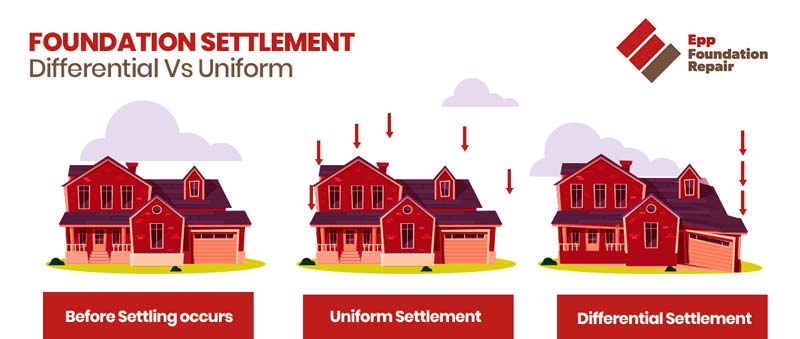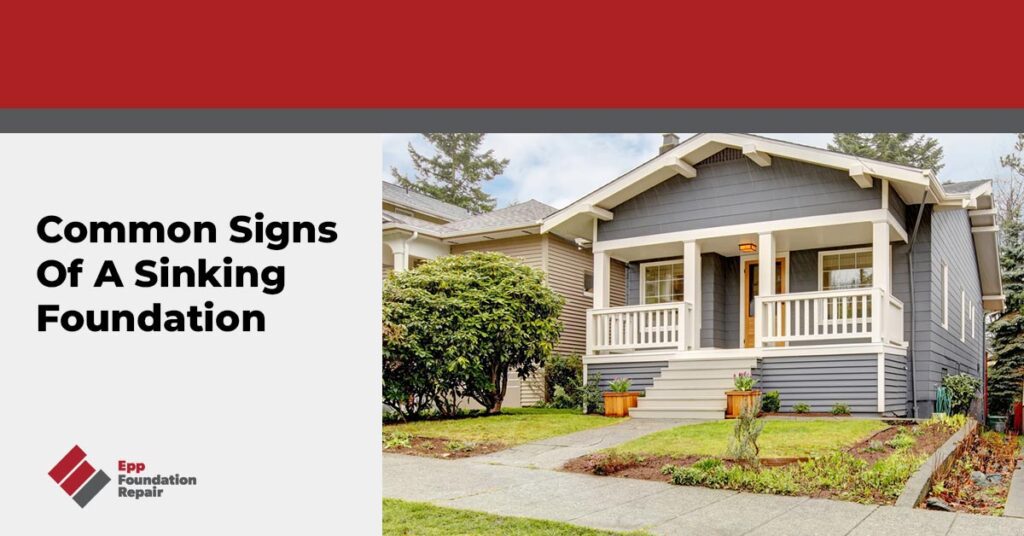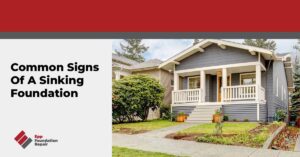Worried that your home is showing the signs of a sinking foundation? If so, don’t hit that back button because that’s what we’re going to cover in this article. We’re going to give you the most common signs of a sinking foundation, repair options, tips on how to prevent foundation trouble, and more.
Your Home’s Structural Integrity Is Only As Good As Its Foundation

The structural integrity of your home is only as good as its foundation. Without a sturdy foundation, your home could suffer severe structural damage, a costly and potentially dangerous problem. Therefore, it’s crucial to make sure your home’s foundation is in good condition and well-maintained to ensure the safety and longevity of your home. Investing time and money into maintenance and, when necessary, foundation repairs will save you from significant headaches and expenses in the future.
When We Say A “Sinking Foundation,” What Do We Mean Exactly?
When we say “sinking foundation,” we’re referring to differential settlement. Differential settlement is when the foundation of a building settles unevenly into the ground, causing certain areas to sink lower than others.
Various factors can contribute to differential settlement, including changes in soil composition, poor construction practices, or even natural disasters like earthquakes.
Differential settlement can lead to significant structural problems, such as wall cracks or uneven floors. If left untreated, differential settlement can pose serious safety risks and compromise the integrity of the entire structure.
Differential settlement is pretty common, and an experienced foundation repair contractor can almost always fix it in just a few days.

Common Signs Of A Sinking Foundation
Some of the most common signs of a sinking foundation include the following:
- Cracks in walls, ceilings, and floors
- Doors and windows that don’t open and close properly
- Uneven floors
- Stair step cracks in brick or masonry
- Gaps between the walls and the floor or ceiling
- Chimneys or porches that lean away from the house
- Torn or wrinkled wallpaper (The wall behind the wallpaper might be cracked.)
If you notice any of the above, your home’s foundation might be sinking. Therefore, you should have your foundation evaluated by a professional foundation repair contractor or structural engineer right away. Don’t delay. Foundation problems worsen over time, and you’ll pay more for the repair if you wait.
Is A Sinking Foundation Serious?
A sinking foundation is a clear signal that something is wrong with your home’s foundation. So yes, a sinking foundation is serious. If you suspect your foundation is sinking, it’s essential to contact a foundation repair contractor immediately to assess the damage and develop a plan to fix it. Ignoring the problem can lead to even more costly repairs, so it’s always best to take action sooner rather than later.
What Causes A Foundation To Sink?
Differential settlement causes foundations to sink into the ground unevenly. So, the real question is, what causes differential settlement? Various factors, including the following, can cause differential foundation settlement:
- Expansive soil – This is soil with a high percentage of clay. It swells when it soaks up moisture and then shrinks when it dries out. This back and forth, swelling and shrinking, creates movement in the ground under the foundation and can lead to differential settlement.
- Erosion-prone soil – Some types of soil are prone to erosion. If there’s poor drainage under the foundation, soil can wash away, leaving voids behind. If the foundation settles into the voids, the foundation will sink unevenly into the ground.
- Inadequate soil preparation – Soil must be tamped down before anything gets built on it. If this isn’t done correctly, the structure could sink unevenly into the ground after construction.
- Seismic events – Earthquakes, even small ones, can cause a foundation to sink into the ground.
- Other natural disasters – Floods, mudslides, sinkholes, etc.
- Excavation too close to the foundation – If your neighbor digs a big hole too close to your home, it could destabilize the foundation and cause it to sink unevenly into the ground.
If you suspect your foundation is sinking, addressing the issue promptly is essential to prevent further structural damage and potentially hazardous conditions. Contact a foundation repair contractor right away and ask for an inspection.
How Are Sinking Foundations Repaired?
Fortunately, there are various ways to repair a sinking foundation. One popular method is underpinning, which involves using push or helical piers to add support to the foundation. For more information about underpinning and how it works, see What Is House Underpinning?
How To Help Prevent Foundation Problems
Believe it or not, most foundation problems are caused by excess moisture in the soil around the foundation. Therefore, you can help prevent foundation problems from occurring in the first place by getting groundwater under control. Here are some tips to help you do that:
- Clean your gutters regularly to ensure they’re not full of decaying leaves and other debris. This will keep water flowing in the gutter instead of spilling over the side of your home and soaking the ground around the foundation.
- Use downspout extensions to direct runoff away from the foundation before release. These are inexpensive and easy to install.
- Consider relocating any water-hungry vegetation planted next to the house.
- If necessary, regrade the yard around your home so it slopes away from the foundation. This will keep groundwater from draining toward the foundation.
- Install a drain tile system around the perimeter of your home. A drain tile system helps direct water away from the foundation, preventing excess moisture from building up in the soil and causing foundation damage. For more information about drain tile systems, see The Importance Of Proper Foundation Drainage Around Your Home.
These proactive steps will lessen the likelihood of foundation damage caused by excess soil moisture.
Knowing the warning signs of a sinking foundation is vital to protecting your home’s structural integrity. The good news is that most sinking foundations can be repaired.
If you think your home’s foundation is sinking, contact us today to schedule a foundation evaluation. If we find an issue, we’ll give you a repair estimate. Since 1994, we’ve helped clients in Lincoln, Omaha, Kearney, Southeastern Nebraska, Northwestern Missouri, and parts of Northeastern Kansas with foundation repair, basement waterproofing, crawl space encapsulation, and concrete leveling for their homes.







